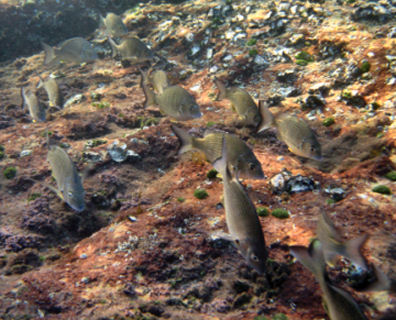Just an hour’s swim in water lightly contaminated with a common pollutant can turn fish into rejects with an odor that causes their untainted schoolmates to shun them, researchers say.

In a lab test, brief exposure to 4-nonylphenol (4-NP), a surfactant used in many soaps, detergents, and other products, disrupted the normal tendency of banded killifish (Fundulus diaphanus) to cluster in shoals, says Ashley J. W. Ward, now of the University of Sydney in Australia. Contaminant concentrations were similar to what the fish might encounter near a sewage treatment outlet, he and his colleagues report online in Proceedings of the Royal Society B.
The finding ranks as “the first demonstration that low levels of a common environmental contaminant can affect shoaling,” comments Bob Wong of Monash University in Melbourne, Australia.
The first generation of experiments on fish exposure to pollutants focused on physiological effects, but research is now turning to subtle effects on behavior, says Wong.
Breakdown of shoaling behavior bodes ill for fish. They improve their odds of surviving attack when they gather in swirling masses. A predator loses its edge when it lunges into the confusion and has to pick a target, an effect described as “the dog-with-two-bones problem,” says Ward. Shoaling brings other benefits, such as efficiency in locating food and picking up signs of danger. Anything that sabotages this behavior suggests “huge consequences to fitness,” says study coauthor Suzanne Currie of Mount Allison University in Sackville, New Brunswick.
Her lab had been studying the effects of 4-NP on fish. This chemical shows up in pesticides, detergents, and processing chemicals for sewage plants. “It’s virtually ubiquitous,” says Ward.
Currie and her colleagues had previously found that low concentrations of 4-NP upset the social hierarchy among trout, inflaming aggression. To look in more detail at social responses to the pollutant, Ward, Currie, and their colleagues switched to the small, brownish killifish, notable for its strong shoaling instinct.
The researchers gave one cluster of fish a short swim in 4-NP at concentrations of 1 microgram per liter and 2 µg/l. Even the higher concentration is too low to cause signs of stress, says Ward. Concentrations near sewage treatment outfalls range from 0.5 µg/l to 343 µg/l, according to the 2002 Helsinki Commission Report.
Researchers then put the fish in an aquarium of uncontaminated water and let the flow from it carry the fishes’ body odor as it washed down over a test subject in another tank. Normally, the downstream killifish would swerve into the odor trail of potential pals ahead. In this case, the test fish moved to avoid the plume.
When the researchers switched the procedure, bathing the test fish but not the upstream cluster in 4-NP, the effect disappeared. The pollutant isn’t disrupting the ability to pick up odor cues, says Ward. It’s changing the signal itself.
Other pollutants, such as cadmium, are known to jam a fish’s odor receptors, so soups of pollutants worry Ward. “There could be a horrible, synergistic effect,” he says.





